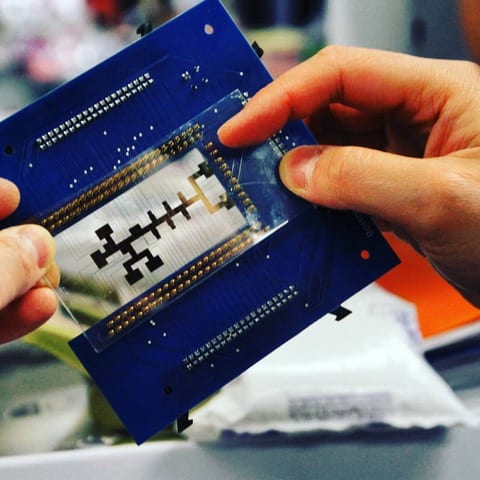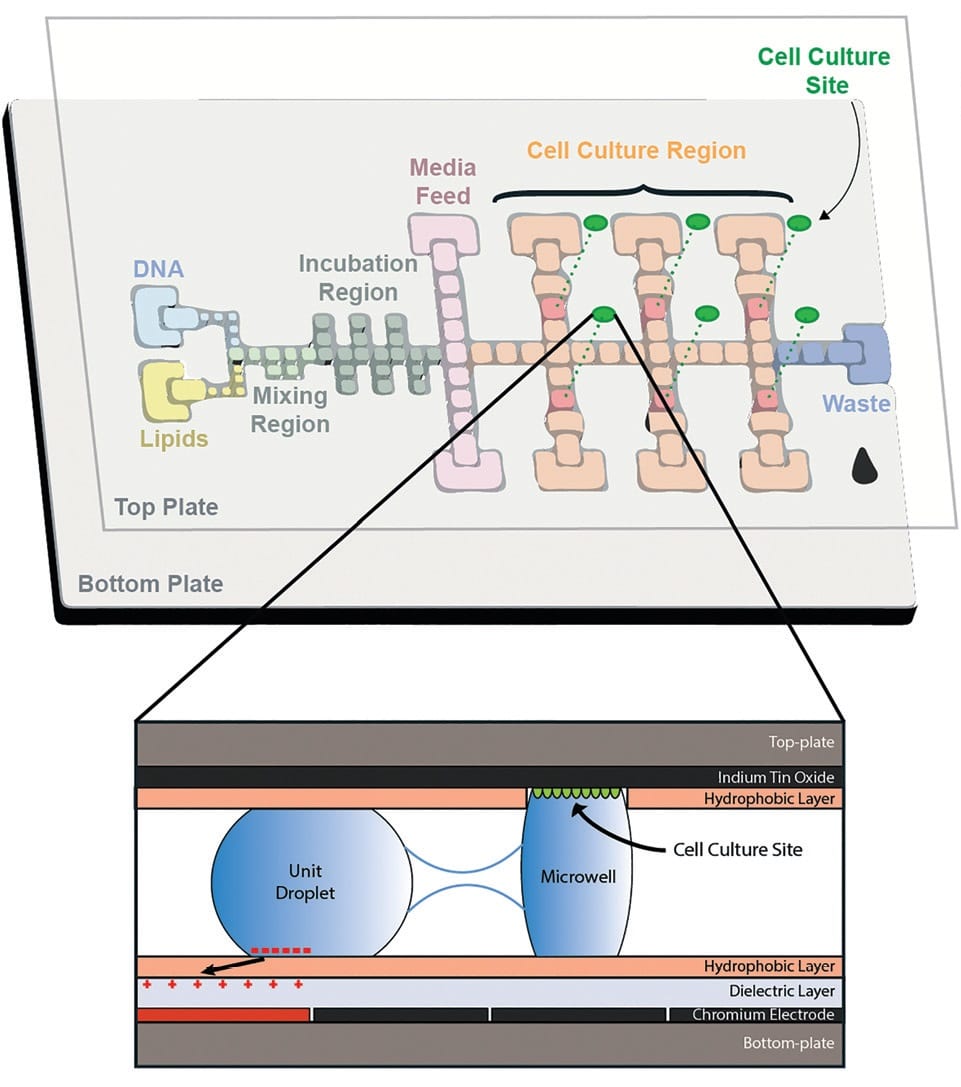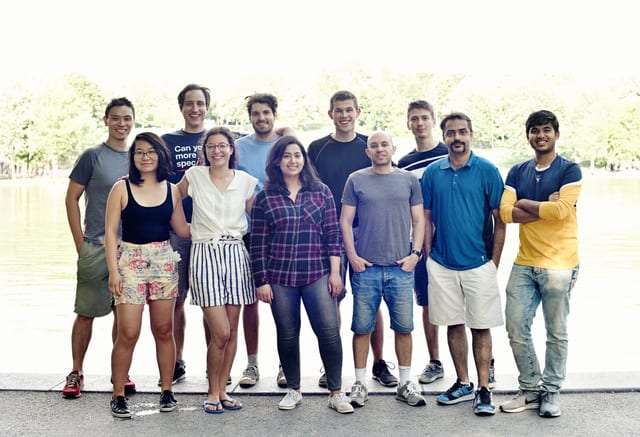
Gene editing is a very common process in biology. Cancer research, T-cell treatment preparations or gene therapy are some examples of application. However, the editing remains time-consuming (typically, it takes several months to engineer T-cells for a cancer treatment) and, moreover, results tend to depend on factors such as who conducted the experiment and the time of the day it was performed. Dr. Steve Shih, director of the Shih Lab in Concordia, experienced these inconsistencies first-hand during his research into gene editing, and the unreliability frustrated him. “Frustration leads to new projects!” he proclaims with a smile: repeating the same experiments and painfully observing the variable results gave Dr. Shih an idea for how to improve things. His idea can be summed up in a single word: standardization.
Now, this idea has turned into a project and a concrete device using microfluidics, called the ACE platform (for Automated CRISPR Editing platform), from the work of Dr. Shih and the students of his lab. I have had the chance to interview Dr. Steve Shih and Angela Quach, the second author of the article “An automated microfluidic gene-editing platform for deciphering cancer genes”: this article is a proof of concept of the ACE platform. The following summarizes our discussion.
The ACE project
Before starting his own lab at Concordia, Dr. Shih did a PhD in microfluidics, and through a desire to explore something different, he did his post-doc in the field of synthetic biology. During this period, he became aware of the many challenges that exist in doing CRISPR itself, even in simple steps. Gene editing requires a lot of time and repetitive tasks. Uniting his microfluidics background with his training in synthetic biology led him to ask the following question: “Why not use microfluidics as a tool to automate the gene editing process?”.
This led to the ACE platform project. This is a microfluidic chip (Figure 1) that enables the automation of the gene editing steps (culture, delivery, analysis). This chip is based on digital-microfluidics, which means that the liquid handling relies on the manipulation of microdroplet individually. To do so, the chip is composed of a combination of hydrophobic layers, hydrophilic wells, dielectric layers and electrodes to control the movement (Figure 2). This allows one to merge, mix or even split droplets automatically by applying tension on the electrodes.
In the article we discussed, the team tests the ACE platform on basic gene editing methods, as simple knock out or gene transfection, or exploration of a known cancer pathway. This is a proof of concept of this device: for the first time, lung cancer cells have been cultured, edited and analyzed in a digital-microfluidics platform. In fact, the range of application of this device is wide, and this could become a remarkable asset to help scientists in their work.

Standardization and automatization: a serious need in gene editing
“Biology is very difficult” admits Dr. Shih, “So I am hoping that this technology will be a step toward generalizing and standardizing technology”. Standardization and automatization would permit greater reliability and reproducibility. Indeed, through standardisation, the different labs would use the same methods and protocols for similar experiments, which means that there would be less variations between results due to protocol differences. Moreover, with automatization, the human induced error is reduced. This way, reproducibility is improved.
When we look at what are the biological tools on the markets today, there is a lack of tools for the dynamic handling of fluids. Robotics can be employed, but they can be difficult to configure, and only the wealthiest laboratories can afford such tools. The ACE platform can hopefully become a common benchtop instrument (like the PCR thermo cycler is nowadays), that can be put in clinics and laboratories to enable gene editing on demand. This may help the scientists having more reliable results while saving time. The patients could also benefit from it: having such a device would reduce the time for a personalized treatment to be available. For example, one treatment for cancer consists in editing immune T-cells that are re-injected into a patient. This treatment currently takes months, while the ACE platform could reduce the delay to a matter of days.
“Science is funny” observes Dr. Shih, “because we always teach our kids to be patient, but in science we really are lacking patience: that is why we want to have more efficient devices to have the responses quicker, so that we can go to the next step faster”
In a nutshell, with standardized dynamic technology, a treatment could be brought faster so that it relieves the patients’ suffering.
Image analysis: a new standard?
The ACE platform allows one to view the cells without harming them. To analyze the cells, the team used an imaging pipeline (a succession of image processing steps). This could be used as a standard too, but the team underlines that the image analysis is not fully automatic, and it needs the thresholds to be changed several times for different experiments. Moreover, there is a need to use other cell imaging methods, such as flow cytometry, in conjunction to confirm the results. Integrating a camera in the platform and finding ways to improve cell imaging is a current challenge of the Shih lab. According to Dr. Shih, the fact that imaging devices such as cameras are getting smaller and smaller will ultimately make this problem tractable.
A wide range of applications
The ACE platform can be used in the context of a lot of diseases: cancer, muscle dystrophy, auto-immune diseases… In principle, it can be applied to any domain where genes are targeted. The only challenge is to make protocols for all these different cells to survive. It appears that one of this technology’s assets is versatility: it is not only focused on one specific application but could be applied to many applications related to genetics, with the condition to have a proper protocol for it.
Optimizing the fabrication process
One of the challenges before spreading the ACE platform as a common benchtop instrument is optimizing fabrication methods. Currently, the fabrication process is a quite simple step by step process. However, it needs specialized procedures like using a clean room, and it can only create 20 to 30 devices at a time.
In order to have a huge impact, there is a need to find manufacturing methods that allows to make the devices cheap and easy to produce in big quantities. This question needs some time to be addressed and the Shih lab is currently doing research to find solutions.
This device has a huge potential and a promising future
After the first proof of concept of the ACE platform on the simplest CRISPR gene-editing methods, Dr. Shih wants to go further and to show the real potential of the device. For instance, he aims to explore new cancer pathways. Angela Quach, who is now in charge of the project, is using the ACE platform to study breast cancer, in collaboration with the University of Montreal (UdeM). The goal is to reproduce the experiments UdeM does concerning investigation on certain cancer pathways, with the particularity of using the ACE platform. This way, she can prove that the ACE platform can be efficiently used in research works, and that it is not only limited to CRISPR: the study with UdeM uses interferent RNA. On top of that, the ACE platform can also be used with other types of gene-editing methods.
Currently, some unsolved questions remain, like “Are electrostatic forces used to move droplets changing cells morphology?” or “Are the T-cell that can be crafted from this platform harmless for the human body?”. Further studies on the ACE platform need to be done in order to quantify the actual effects of this technology on the cells.
This project has a promising future, and its versatility allows it to adapt to the needs of the clinicians or scientists. This huge potential encourages to boost the creativity of the team to see new possibilities and to make protocols for them.
Conclusion
Dr. Shih’s team has created a gene editing tool with amazing potential, which can bring normalization and automatization to a field that really needs it. The field of application is huge, and this could be invaluable for scientists, clinicians, and patients. Currently, some challenges need to be tackled such as optimizing the production process and quantifying the actual effects of this device on cells. Hopefully, according to Dr. Shih, this device could become a standard in genetics labs within 3 to 5 years.

__________________________________________________________________________________________________________________________
Reference
Sinha, H., Quach, A.B.V., Vo, P.Q.N., Shih, S.C.C., An automated microfluidic gene-editing platform for deciphering cancer genes, Lab on Chip (2018), 18, 2300-2312
